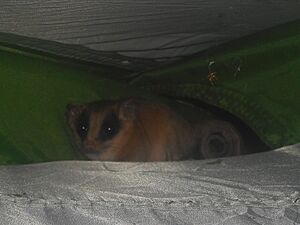Mexican mouse opossum facts for kids
Quick facts for kids Mexican mouse opossum |
|
|---|---|
 |
|
| Conservation status | |
| Scientific classification | |
| Genus: |
Marmosa
|
| Species: |
mexicana
|
 |
|
| Mexican mouse opossum range | |
The Mexican mouse opossum (Marmosa mexicana) is a small animal that lives in North and Central America. It's a type of opossum and belongs to a family called Didelphidae. These opossums are known for being marsupials, which means their babies grow in a special way.
Contents
What Does It Look Like?
The Mexican mouse opossum is a small to medium-sized animal. It has reddish-brown fur that can be bright or dull. The fur on its back and sides is dark at the bottom. The tips of the hairs are reddish-brown.
Its forehead and nose are lighter in color. It has black rings around its eyes. These rings can be darker or lighter depending on where the opossum lives. Its cheeks, throat, and belly are yellowish. It also has a white patch on its chest.
The opossum's nose is pink, and its ears are grayish-brown. Its tail is a dark brown color. The tail is about the same length as its body. It can use its tail to grab things, like branches. Even though the tail looks bare, it has a thin layer of hair.
How Do They Have Babies?
Like all marsupials, Mexican mouse opossums have a short pregnancy. The babies are born very tiny and not fully developed. Most of their growth happens after birth while they drink their mother's milk.
Scientists think their reproduction is similar to another opossum, Marmosa robinsoni. That species gives birth to 6 to 14 babies. The pregnancy only lasts about 14 days.
The tiny babies are only about 12 millimeters long when they are born. They attach themselves to their mother's feeding spots. They stay there for about 30 days. Unlike some marsupials, female mouse opossums do not have a pouch. This means the babies are not protected in a pouch as they grow.
The babies' eyes do not open until they are about 39 to 40 days old. They are likely ready to stop drinking milk around 65 days old. These opossums might only live for about one year.
Where Do They Live?
The Mexican mouse opossum is found in several countries. These include Belize, Costa Rica, El Salvador, Guatemala, and Honduras. They also live in eastern Mexico, as far north as Tamaulipas. You can also find them in Nicaragua and western Panama.
They can live from sea level up to very high places. Some have been found at 3000 meters (about 9,800 feet) on a volcano called Volcán Tacaná. However, they are most often found below 1800 meters (about 5,900 feet).
What Kind of Homes Do They Like?
This opossum lives in many different types of forests. It can be found in both old, untouched forests and newer, regrowing forests. This includes warm, wet tropical rainforests. They also live in dry forests where trees lose their leaves.
Sometimes, they live in cloud forests, which are often misty. They can even be found in farm areas like plantations. They also live in grasslands. For example, they live in the Petenes mangroves, which are special coastal forests in the Yucatán Peninsula.
What Do They Do?
The Mexican mouse opossum mostly lives in trees. It can be found from the ground all the way up to 30 meters (about 98 feet) high in the tree canopy. They are active at night, which means they are nocturnal. They also like to be alone.
Their diet includes insects and fruit. They are thought to build nests. These nests can be in burrows underground or up in trees. They often use abandoned bird nests.
The front paws of the Mexican mouse opossum are very good at grabbing and moving things. They use their paws to dig burrows in the ground. These burrows can be about 30 millimeters (1.2 inches) wide and 40 centimeters (16 inches) long. The opossum then fills the burrow with leaves to make a cozy nest. If they feel threatened, they might open their mouth and hiss. They can also make a clicking sound.
How Are They Protected?
Right now, there are no big threats to the Mexican mouse opossum. This means their numbers are stable. However, forests are being cut down more and more. Also, people are using more natural resources. If this continues, the places where these opossums live could be in danger in the future. It's important to protect their habitat so they can continue to thrive.


